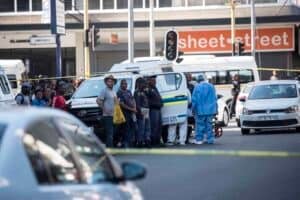The global norm is one police officer servicing 220 people – but being ‘extremely’ understaffed, a South African cop is burdened with 375 citizens to look after.

The majority of SA’s police stations are understaffed to such an extent that they do not meet the United Nations’ (UN) recommended police-to-citizen ratio of one police officer to every 220 people, says Police Minister Bheki Cele.
The current ratio in SA is one police officer to every 375 people.
In a written response to a parliamentary question by Democratic Alliance (DA) police spokesperson Andrew Whitfield, Cele said 90% of police stations in four of the nine provinces do not meet the UN ratio.
Only 16.1% of all SA stations meet this standard, with the worst-performing provinces being Gauteng, KwaZulu-Natal and the Western Cape. Each province was “extremely undercapacitated”.

“Police daily face uphill battles and are expected to provide an efficient service in the face of such extreme staff shortages,” said Whitfield. “It is very hard for our men and women in blue to do their jobs when there simply are not enough officers to protect the people they are meant to.”
According to Andrew Faull, senior researcher, justice and violence prevention at the Institute for Security Studies (ISS), the police had long been understaffed an urgent solution was needed.
“There is no UN recommended police-citizen ratio. This is an SA myth. We need the appropriate number of police for each area, not a general formula,” said Faull. “If we don’t have the resources to staff stations, we need to make sure those stations where the most harm is recorded are staffed and managed appropriately.”
In the past financial year, the number of murders increased from 56 to 58 a day on average. Over the past seven years, murder has risen by 35%.
This reverses the downward trend that was evident between 1995 and 2011, during which time murder decreased by 55%.
When he announced the latest crime statistics last week, Cele said the top 30 high crime stations were identified and introduced in the Saps’ 2019/2020 annual performance plan as a mechanism to prioritise the 30 stations.
Cele said the resource allocation to a police station may also be influenced by certain functions performed at a station, such as court duties, which will be influenced by the size of the court and the concomitant resource requirement.
“Certain police stations have relatively small resident populations, but large migrant populations,” said Cele.
Whitfield said Cele should urgently prioritise the recruitment of police reservists to ensure SA has more boots on the ground to improve police visibility in all communities.
“The DA will call on the minister to immediately address these shortages, with a priority focus on provinces where over 90% of stations are understaffed.
“The minister should start by cutting the VIP protection budget and reallocate this funding to the frontline of policing,” Whitfield said.
If the police stations could be adequately resourced with the personnel they needed, it would increase visible policing, while also increasing the Saps’ investigative and intelligence operations, he said.
“This will in no doubt lead to faster and increased conviction rates, with dangerous criminals behind bars, instead of on the streets.”
For more news your way, download The Citizen’s app for iOS and Android.







